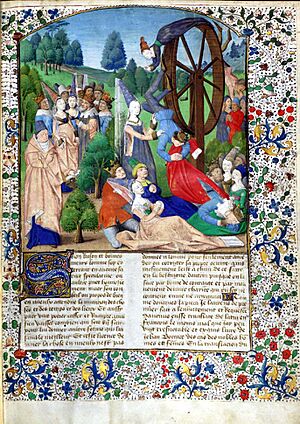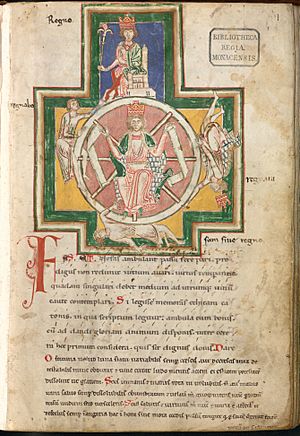The Wheel of Fortune facts for kids
- For other uses, see Wheel of Fortune.

The Wheel of Fortune, also known as Rota Fortunae, is an old idea from ancient and medieval times. It represents how Fate or luck can change quickly and unexpectedly. The wheel belongs to the goddess Fortuna. She spins it randomly, causing people's lives to change. Some might face bad luck, while others get very lucky.
Contents
Where Did the Wheel of Fortune Idea Come From?
The idea of the Wheel of Fortune began a very long time ago. The Roman speaker Cicero used this concept. The wheel was first linked to the Roman goddess Fortuna. Her name might come from Vortumna, meaning "she who revolves the year."
Later, the idea of Fortuna was also used in Christian beliefs. A Roman philosopher named Boethius, who lived around 524 AD, wrote about the Wheel of Fortune in his book Consolatio Philosophiae. His writings helped make the Wheel of Fortune a popular idea during the Middle Ages.
The Wheel in Carmina Burana
The Wheel of Fortune is a very important symbol in the Carmina Burana. This is a collection of over a thousand poems and songs. Students and clergy wrote them in the early 13th century. Many of these writings were about everyday life.
Two famous poems from the collection are "Fortuna Imperatrix Mundi" (Fortune, Empress of the World) and "Fortune Plango Vulnera" (I Bemoan the Wounds of Fortune). These poems talk about how powerful and unpredictable Fortune's wheel is. They describe how the wheel turns, bringing some people to power and wealth, while others fall to ruin. It reminds everyone, even kings, that their luck can change at any moment.
How the Wheel of Fortune Is Used Today
The image of Fortune and her Wheel has stayed popular throughout history.
The famous writer William Shakespeare used the idea in his plays. In Hamlet, he wrote about the "slings and arrows of outrageous fortune." He also imagined breaking the wheel's parts.
In the 20th century, the composer Carl Orff created new music for parts of the Carmina Burana. His well-known piece, "O Fortuna", is based on the poem Fortuna Imperatrix Mundi. This powerful song is often heard in movies and commercials today.
Sometimes, Fortuna appears in modern books. She is often connected to gamblers. Dice are also seen as a modern symbol for uncertain luck, much like the old Wheel of Fortune.
- Boethius, The Consolation of Philosophy, trans. W.V. Cooper (London: J.M. Dent, 1902)
- Geoffrey Chaucer, The Canterbury Tales: The Monk's Tale
- Thomas Malory, Le Morte d'Arthur, Chapter XVII'
- William Shakespeare, Henry V, Act 3 Scene VI
- In the novel "Confederacy of Dunces," the main character, Ignatus J. Reilly, often talks about "Fortuna's wheel" and Boethius's writings.
See also
 In Spanish: Rueda de la Fortuna para niños
In Spanish: Rueda de la Fortuna para niños


